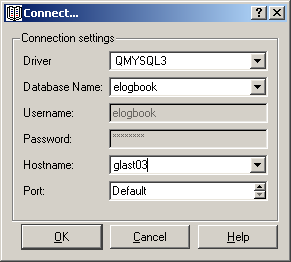
Installation Instructions for E-Logbook:
For installation instructions of E-Logbook up to and including E-Logbook 3.3.0 click here.
A. To install E-Logbook for remote database access:
Make sure the following software is installed in your machine:
|
COMPONENT |
VERSION |
LOCATION |
LICENSE |
|
E-Logbook |
Latest |
SLAC Copyright |
|
|
MySQL |
4.1.7 |
As indicated on website |
|
|
Python |
2.3.5 |
As indicated on website |
Unix Environment Additional Packages:
|
COMPONENT |
VERSION |
LOCATION |
LICENSE |
|
Qt |
3.3.3 |
As indicated on website |
|
|
PyQt |
3.14.1 |
http://www.riverbankcomputing.co.uk/pyqt/index.php |
As indicated on website |
|
Sip |
4.3.2 |
http://www.riverbankcomputing.co.uk/sip/index.php |
As indicated on website |
|
Doxygen |
1.4.5 |
http://www.stack.nl/~dimitri/doxygen/ |
As indicated on website |
In Windows:
Add C:\Python23\ to PATH.
Add C:\Program Files\MySQL\MySQL Server 4.1\bin to PATH.
To Launch E-Logbook:
If there is a shortcut in the desktop double click on it. Otherwise open a Command Prompt (it can be the same as above) and enter:
Once the Connect window appears select glast03 as hostname for access to a mirror copy of the cleanroom E-Logbook database:

B. To create a local copy of the E-Logbook Database:
Make sure the following software is installed in your machine:
|
COMPONENT |
VERSION |
LOCATION |
LICENSE |
|
E-Logbook |
Latest |
SLAC Copyright |
|
|
MySQL |
4.1.7 |
As indicated on website |
|
|
MySQL Control Center |
0.9.4 |
As indicated on website |
|
|
Python |
2.3.5 |
As indicated on website |
|
|
PyQt |
3.14.1 |
As indicated on website |
Add C:\Python23\ to PATH.
Add C:\Program Files\MySQL\MySQL Server 4.1\bin to PATH.
Check that there exists TOOLS_ROOT in your workstation environment variables list.
Make sure that ELogbook is under the TOOLS_ROOT directory.
Open the MySQL Control Center GUI:
o Right click User Administration and select New User:
§ Select Global Privileges:
§ Under Username enter: root
§ Under Host enter: localhost
§ Under Password enter: A password of your choice
To create a local copy of MySQL E-Logbook database: Open up a Command Prompt and enter the following:
mysql –u root –p –e "drop database elogbook" (Ignore the error)
mysql –u root –p -e "create database elogbook"
mysql –u root –p elogbook < %TOOLS_ROOT%\Elogbook\MySQLelogbook\elogbookX*.sql
* X indicates the release version of an empty copy of ELogbook you are about to test, for example 340.
or
mysql –u root –p elogbook < \\copypath\Y.dmp
* Y indicates a backup copy of the cleanroom database you are about to review.
* copypath is the path location of the backup copy you are about to review.
At the MySQL Control Center GUI:
o Right click User Administration and select New User:
§ Select ELogbook
§ Under Username enter: Elogbook
§ Under Host enter: localhost
§ Under Password enter: Elogbook
o MySQL CC will help you verify data entry and retrieval during the test.
To Launch E-Logbook:
If there is a shortcut in the desktop double click on it. Otherwise open a Command Prompt (it can be the same as above) and enter:
o %TOOLS_ROOT%\Elogbook\start\startElogbook.bat (launches E-Logbook).
Please contact the Project Administrator if you have problems or any questions (Contacts Page)
Updated 04/25/2006, ATK